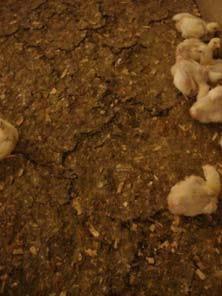A major component of broiler management is maintaining good litter quality throughout the flock. Litter quality is negatively influenced by moisture. As litter moisture increases, litter quality decreases. Factors that affect litter moisture include drinker management, bird health, bird density, ventilation rates, litter depth and litter type. Typically broiler facilities are bedded with materials that have moisture content less than 10%. Under normal conditions litter moisture at the end of the flock can fluctuate from 25 to 35% depending on the factors above. During the flock the goal is to maintain a litter moisture between 20% and 25%. As litter quality deteriorates, ammonia production increases, microbial loads in the litter increase, and paw quality can decrease, none of which are conducive to good broiler performance. Many people are interested in measuring litter moisture and often are looking for the correct instrument to measure litter quality. It would be nice to have an instrument where a probe could be inserted into the litter and the moisture content value is displayed on a monitor. Currently, there are no moisture meters that return an accurate and/or repeatable measurement. One of the reasons that the moisture meters used for wood, forage or soil moisture do not work could be due to the porosity of litter materials. Since the readings from these instruments are not reliable in litter moisture measurements, the currently accepted way of measuring litter moisture is to use a drying protocol.

Figure 1. Caked litter
In this protocol, a sample of litter is taken from the house. It is recommended that at least three samples be taken with one from the end near the evaporative cooling pads, one from the middle of house and the other in from the rear of the house near the tunnel fans. A trench sample (Figure 2) should be collected from each location which involves taking all the litter in a line from the middle of the house to the sidewall. This ensures that litter from different areas of the house including drinker, feeder, and sidewall as well as from the non-feeder/drinker area in the middle of the house. Once placed in the wheelbarrow or other container, this litter should then be mixed thoroughly and the caked litter should be broken up into the smallest pieces possible.
After the litter is thoroughly mixed, random samples from this homogenous mixture should be collected. Filling a quart bag will provide more than enough material for litter moisture analysis. Be sure to seal the bag completely and do not leave it in the sun or in the heat. For best results the samples should be processed that day. If samples are stored for overnight or longer, they should be refrigerated.
Figure 2. Litter sampling trench
Once in the lab, the samples should be poured into a small container and mixed thoroughly once more. Record the empty pan weight, and then weigh out 50 to 100 g of litter into the pan. The pan should be aluminum or other material that will not be affected by heat or moisture. It is recommended that at least 3 replicates for each sample be used to account for as much variation as possible. After weighing the pan is placed in a drying oven at 120oF for 24 hours. The pan should be removed from the drying oven and the dry weight should be obtained. The percent litter moisture can be calculated using the following equation:
% Litter moisture = 100 - ((Dry litter weight/Wet litter weight) X 100)
Once the percent litter moisture has been calculated, an average of the three replicate samples can be calculated to determine the average litter moisture for each trench sample (front, middle and back). If multiple trench samples were collected then these can be averaged to get the percent litter moisture for the entire house. While this method may be somewhat labor intensive and provides information 24 hours later, it is an approved method that has been found to yield objective measurements that are accurate and repeatable.
Figure 3. Damp litter, dark in color
The litter can be inspected visually; however, monitoring should be more than just monitoring how much caked litter is in a house. Caked litter is a symptom of an earlier moisture problem. Daily monitoring of the floor condition will be a proactive way of preventing caked litter. As ss or used litter become damp they will be darker in color and appearance than the drier floors (Figure 3). Another method of inspecting the litter is to pick up a handful and squeeze it. Litter that has moisture of less than 30% will be friable and will not stick when your hand is relaxed. Litter that is too damp will still clump together. While these methods are good, if an actual number is desired, the litter will have to be dried using the protocol discussed above.
This article was originally published at UGA Cooperative Extension Poultry Housing Tips Vol. 23 no. 3, March, 2011. Engormix.com thanks the authors for this huge contribution.












.jpg&w=3840&q=75)







